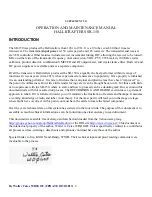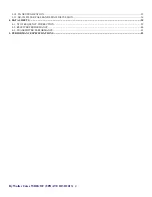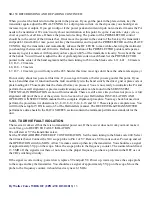
By Walter Cates WD0GOF (UPDATE 10/30/2013)
8
SR-150 REFURBISHING AND REPAIRING CONTINUED:
1-6-3. VFO:
The VFO is comprised of V9 and associated circuitry, VFO correction circuitry and the RIT/CAL circuitry.
1-6-3-1. RIT/CAL
The RIT/CAL ckts are used change the bias voltage on a varicap in the VFO. This is used to make minor
corrections to the VFO frequency. The supply for the RIT/CAL ckt is the regulated 150vdc line. The 150vdc
regulated line by normal standards is pretty stable. The voltage divider for the RIT/cal ckt is isolated from the
reg 150v line by a 180k resistor. The leads from the divider ckt wonder back and forth from the front panel to
Relay K1 and back to the VFO. All this boils down to lots of stray pick up. There is a simple solution to the
problem (drawing located in SUBSYSTEM TECHNICAL INFORMATION section). Replace R81 (180K) with
an 82K resistor and parallel C100 with a 1N4742 zener diode. This will lower the dynamic impedance at the
feed point of the CAL/RIT divider from approximately 14k ohms to 5 ohms. This modification is a highly
recommended option. If you decide to perform this option it must be done before you proceed with the
alignment of the VFO. Set the RIT lever switch to off, adjust the RIT control to the center of its rotation. Set the
CAL control to the center of its rotation. This is the setting for these controls throughout all testing unless
otherwise noted. Set the main tuning to 300 on the black scale. Connect the frequency counter to the tie point of
R15 and C83 (in the cathode ckt of V9B). Fine tune the main tuning for 4550.0 on the counter. Rotate the CAL
control to max ccw and note the counter reading. Rotate the CAL max cw and note the counter reading. The
difference from ccw to cc rotation should be minimum 3 KHz, maximum 4 KHz. An in-depth discussion on the
RIT action and setting is in the SUBSYSTEM TECHNICAL section.
1-6-3-2. VFO CORRECTOR
The VFO correction ckt corrects for the frequency off set between USB and LSB (NOTE: CW operates in the
USB MODE). Before the VFO is aligned it must be established that the correction ckts are working properly.
Connect the frequency counter to the tie point of R15 and C83. Set the function switch to LSB and record the
VFO frequency any band any dial setting. Switch to USB and the frequency should drop approximately 3600
Hz. Now adjust C96 to insure that you can get at least a 4000 Hz difference between USB and LSB. If you can,
then adjust it for a difference of exactly 3600 Hz. If you cannot then there is a fault in the corrector ckt that must
be repaired before you can continue with the VFO alignment.
1-6-3-3. VFO ALIGNMENT
Before starting the VFO alignment go to the SYSTEM TROUBLESHOOTING AND TESTING section and
perform the VFO DRIFT TEST.
Connect the frequency counter to the tie point of R15 and C83 (C83 is in the cathode ckt of V9B). Record the
VFO frequency every 100 KHz from 0 to 500 (black scale). A data sheet is provided in the DATA SHEET
section with the data points and the spec frequencies. You may want to make several copies of the data sheet.
If the actual frequency consistently falls above or below the spec frequency adjustment of trimmer C87 is
indicated. Move the dial to the black 500 index mark (be sure you are looking head on at the dial to eliminate
parallax error). Adjust C87 for exactly 4.3519 MHZ.
Rerun and record the 6 data points again. If at the
Ø or the 500 index mark you are more than 1 KHz off, tracking of C87 and L27 is required.
The original
manual spec at this point is 3 KHZ. But it is normally not difficult to get it right on. So why not try.
Adjust
the tuning dial to the black 500 and adjust L27 for 4.3519 MHz. Adjust the dial to the black Ø and adjust C87
for 4.8519 MHZ. You may have to repeat this several times to get it correct. Under correcting or overcorrecting
at one end or the other is sometimes required to get it to fall in.
Rerun and record the data. If any of the mid
points fall more than 3 KHz from spec knifing of C32A is indicated (I use 1 KHz for my shop spec).
Knifing
should never be attempted on the SR-150 unless you are very skilled at knifing.
C32A is fragile and can be
destroyed very easily. You can split the difference. That is move the end points half the max error in the
opposite direction of the error.
Summary of Contents for SR-150
Page 18: ...By Walter Cates WD0GOF UPDATE 10 30 2013 18...
Page 19: ...By Walter Cates WD0GOF UPDATE 10 30 2013 19 BEFORE CLEANING CLEAN CHASSIS...
Page 20: ...By Walter Cates WD0GOF UPDATE 10 30 2013 20 3 1 2 TUBE SOCKET CLEANING KIT...
Page 21: ...By Walter Cates WD0GOF UPDATE 10 30 2013 21 3 1 3 AIR VARIABLE CLEANING...
Page 30: ...By Walter Cates WD0GOF UPDATE 10 30 2013 30 3 5 5 K3 WIRING AND PIN OUT...
Page 38: ...By Walter Cates WD0GOF UPDATE 10 30 2013 38 4 DATA SHEETS...








































